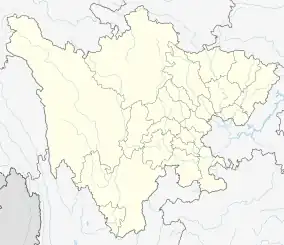Baima Tibetan Ethnic Township
白马藏族乡 | |
|---|---|
 Baima Tibetan Ethnic Township Location in Sichuan | |
| Coordinates: 32°44′32″N 104°19′22″E / 32.74222°N 104.32278°E | |
| Country | People's Republic of China |
| Province | Sichuan |
| Prefecture-level city | Mianyang |
| County | Pingwu County |
| Area | |
| • Total | 784.66 km2 (302.96 sq mi) |
| Population (2018)[1] | |
| • Total | 1,577 |
| • Density | 2.0/km2 (5.2/sq mi) |
| Time zone | China Standard |
Baima Tibetan Ethnic Township (simplified Chinese: 白马藏族乡; traditional Chinese: 白馬藏族鄉; pinyin: Báimǎ Zàng Zú Xiāng) is an ethnic township for Tibetan people under the administration of Pingwu County in northern Sichuan province, China.[2] The Baima language, a threatened language with approximately 10,000 speakers,[3][4] is spoken in the ethnic township.[4] The ethnic township spans an area of 784.66 square kilometres (302.96 sq mi), and has a population of 1,577 as of 2018.[1]
Administrative divisions
As of 2020, it has four villages under its administration:[5]
- Yiwadaire Village (伊瓦岱惹村)
- Eli Village (厄哩村)
- Gaoshinao Village (稿史脑村)
- Yazhezaozu Village (亚者造祖村)
See also
References
- 1 2 3 中国县域统计年鉴·2019(乡镇卷) (in Chinese). Beijing: 中国统计出版社, 国家统计局农村社会经济调查司. May 2020. p. 473. ISBN 9787503791390.
- ↑ 2020年统计用区划代码和城乡划分代码:平武县 (in Chinese). National Bureau of Statistics of the People's Republic of China. Retrieved 7 January 2021.
- ↑ "Did you know Baima is threatened?". Endangered Languages. Retrieved 2021-08-22.
- 1 2 Chirkova, Ekaterina (2005). "Words for 'one' in Baima" (PDF). Cahiers de Linguistique Asie Orientale. 34: 69–99. doi:10.1163/19606028-90000135. Archived (PDF) from the original on 2021-08-22 – via HAL (open archive).
- ↑ 2020年统计用区划代码和城乡划分代码:白马藏族乡 (in Chinese). National Bureau of Statistics of the People's Republic of China. Retrieved 7 January 2021.
This article is issued from Wikipedia. The text is licensed under Creative Commons - Attribution - Sharealike. Additional terms may apply for the media files.